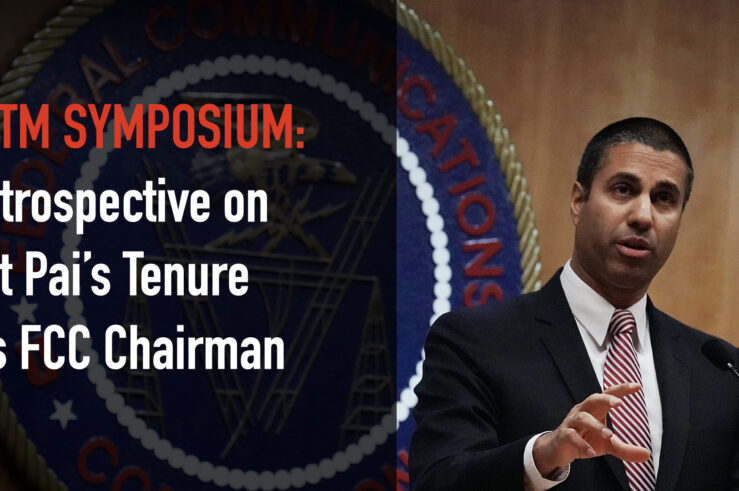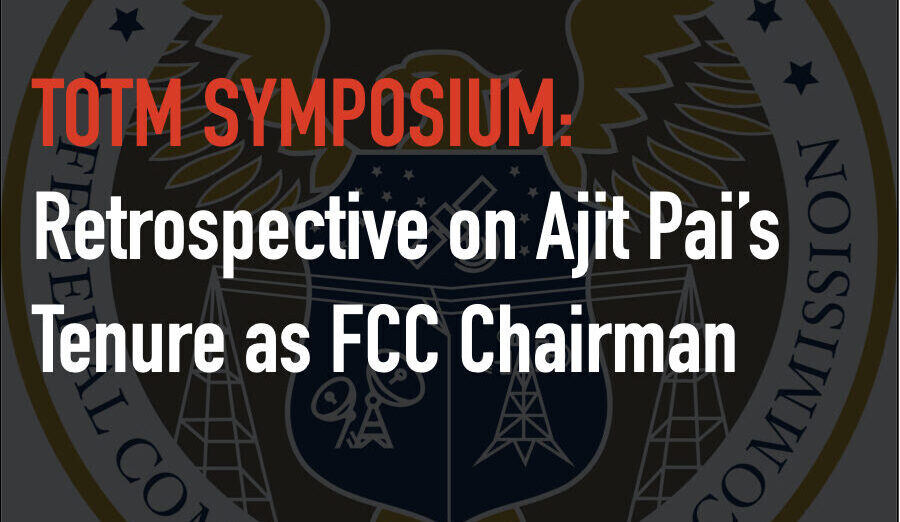
This article is a part of the Retrospective on Ajit Pai's Tenure as FCC Chairman symposium.

It would be impossible to describe Ajit Pai’s tenure as chair of the Federal Communications Commission as ordinary. Whether or not you thought his regulatory style or his policies were innovative, his relationship with the public has been singular for an FCC chair. His Reese’s mug, alone, has occupied more space in the American media landscape than practically any past FCC chair. From his first day, he has attracted consistent, highly visible criticism from a variety of media outlets, although at least John Oliver didn’t describe him as a dingo. Just today, I read that Ajit Pai single-handedly ruined the internet, which when I got up this morning seemed to be working pretty much the same way it was four years ago.
I might be biased in my view of Ajit. I’ve known him since we were law school classmates, when he displayed the same zeal and good-humored delight in confronting hard problems that I’ve seen in him at the commission. So I offer my comments not as an academic and student of FCC regulation, but rather as an observer of the communications regulatory ecosystem that Ajit has dominated since his appointment. And while I do not agree with everything he’s done at the commission, I have admired his single-minded determination to pursue policies that he believes will expand access to advanced telecommunications services. One can disagree with how he’s pursued that goal—and many have—but characterizing his time as chair in any other way simply misses the point. Ajit has kept his eye on expanding access, and he has been unwavering in pursuit of that objective, even when doing so has opened him to criticism, which is the definition of taking political risk.
Thus, while I don’t think it’s going to be the most notable policy he’s participated in at the commission, I would like to look at Ajit’s tenure through the lens of one small part of one fairly specific proceeding: the commission’s decision to include SpaceX as a low-latency provider in the Rural Digital Opportunity Fund (RDOF) Auction.
The decision to include SpaceX is at one level unremarkable. SpaceX proposes to offer broadband internet access through low-Earth-orbit satellites, which is the kind of thing that is completely amazing but is becoming increasingly un-amazing as communications technology advances. SpaceX’s decision to use satellites is particularly valuable for initiatives like the RDOF, which specifically seek to provide services where previous (largely terrestrial) services have not. That is, in fact, the whole point of the RDOF, a point that sparked fiery debate over the FCC’s decision to focus the first phase of the RDOF on areas with no service rather than areas with some service. Indeed, if anything typifies the current tenor of the debate (at the center of which Ajit Pai has resided since his confirmation as chair), it is that a policy decision over which kind of under-served areas should receive more than $16 billion in federal funding should spark such strongly held views. In the end, SpaceX was awarded $885.5 million to participate in the RDOF, almost 10% of the first-round funds awarded.
But on a different level, the decision to include SpaceX is extremely remarkable. Elon Musk, SpaceX’s pot-smoking CEO, does not exactly fit regulatory stereotypes. (Disclaimer: I personally trust Elon Musk enough to drive my children around in one of his cars.) Even more significantly, SpaceX’s Starlink broadband service doesn’t actually exist as a commercial product. If you go to Starlink’s website, you won’t find a set of splashy webpages featuring products, services, testimonials, and a variety of service plans eager for a monthly assignation with your credit card or bank account. You will be greeted with a page asking for your email and service address in case you’d like to participate in Starlink’s beta program. In the case of my address, which is approximately 100 miles from the building where the FCC awarded SpaceX over $885 million to participate in the RDOF, Starlink is not yet available. I will, however, “be notified via email when service becomes available in your area,” which is reassuring but doesn’t get me any closer to watching cat videos.
That is perhaps why Chairman Pai was initially opposed to including SpaceX in the low-latency portion of the RDOF. SpaceX was offering unproven technology and previous satellite offerings had been high-latency, which is good for some uses but not others.
But then, an even more remarkable thing happened, at least in Washington: a regulator at the center of a controversial issue changed his mind and—even more remarkably—admitted his decision might not work out. When the final order was released, SpaceX was allowed to bid for low-latency RDOF funds even though the commission was “skeptical” of SpaceX’s ability to deliver on its low-latency promise. Many doubted that SpaceX would be able to effectively compete for funds, but as we now know, that decision led to SpaceX receiving a large share of the Phase I funds. Of course, that means that if SpaceX doesn’t deliver on its latency promises, a substantial part of the RDOF Phase I funds will fail to achieve their purpose, and the FCC will have backed the wrong horse.
I think we are unlikely to see such regulatory risk-taking, both technically and politically, in what will almost certainly be a more politically attuned commission in the coming years. Even less likely will be acknowledgments of uncertainty in the commission’s policies. Given the political climate and the popular attention policies like network neutrality have attracted, I would expect the next chair’s views about topics like network neutrality to exhibit more unwavering certainty than curiosity and more resolve than risk-taking. The most defining characteristic of modern communications technology and markets is change. We are all better off with a commission in which the other things that can change are minds.



